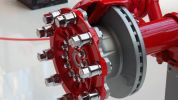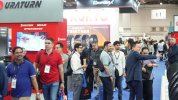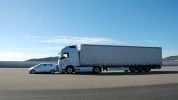The Switch IeV 3 and IeV 4 make interesting electric light-duty trucks in terms of emissions and TCO.
By: Bhushan Mhapralkar
TCO is of prime importance to any operator, big and small. It is that factor which determines his business viability and growth. So imagine a big electric fleet company CEO speak about the decision to purchase the Switch IeV 4 for use in last-mile delivery segment with an eye on the lowest TCO it would offer. His equation about the vehicle providing an ROI in five years is even more interesting. Post five years of loan repayment, the entire earning from the vehicle will be that of the company, he announced.
Made on a dedicated line inside Ashok Leyland’s Hosur plant, the Switch IeV 4 and IeV 3 began deliveries in April and July, respectively. They share their cabin and other mechanicals with the Ashok Leyland Bada Dost and Dost.
Offering zero tailpipe emission, the two light-duty electric trucks are poised to help end customers in e-commerce, FMCG and other sectors like Amazon and Flipkart to pursue their net zero goals.
So it is with much curiosity that I got behind the wheel of the Switch IeV 3 on the testing grounds inside the Ashok Leyland Technical Centre in Chennai.
The turn of the key leads to the all-digital instrument cluster lighting up like a Christmas tree and then settling down with a ‘Zero’ on the LCD readout and a ‘Ready’ sign on the top centre. This sign implies that the e-truck is ready to operate.
A small catch, though; my earlier attempt to ‘start’ it failed. The switch marked ‘N’ in the gear shift console, located where a central console in a passenger car typically would, did not glow. The entire procedure of turning off the key, engaging and disengaging the parking brake, keeping the brake pedal pressed and doing two turns of the key had to be repeated. In short, a ‘reboot’ was called for!
Pushing the ‘D’ switch next to ‘N’ and a firm press of the accelerator pedal saw the e-truck move away from standstill. It picked up pace – entering the high-speed track – entirely predictably. No hesitation or any drama – just the changing of the number on the LCD read out as speeds up to 60 kmph were achieved.
Some motor-like whine at lower speeds was soon replaced by wind noise and road noise, the approximately three km high-speed track with banked corners allowing good speeds to be attained across one of the lonely straight patches.
Placed at a lower price point (as compared to the IeV 4), according to Mahesh Babu, CEO, Switch Mobility, the e-truck has a 2.5-tonne GVW and 1,200 kg payload capacity. It is fitted with a 25.6 kWh liquid-cooled Lithium-ion battery pack that helps to produce 53.5 hp of peak power and 190 Nm torque.
Completely localised, according to Mahesh Babu, with only the battery cells sourced from outside, the IeV 3 has a ground clearance of 177 mm and rides on 185 R14 LT 8 PR radial tyres.
Attaining speeds of up to 80 kmph in ‘S’ mode, the vehicle has its battery pack located at the centre and between the chassis long members. The controlling electronics is where the ICE in Ashok Dost is situated. The permanent magnet synchronous motor (PMSM) motor is attached to the ‘live’ rear axle.
The architecture of the IeV 4 is similar to that of the IeV 3 except for the detailed changes such as the cabin and chassis, which are shared with the Ashok Leyland Bada Dost. Riding on 7.00 R15 LT 12 PR radial tyres and having bigger dimensions as well as a wider front and rear track, the IeV 4 is fitted with a 32.2 kWh lithium-ion battery pack that helps to produce 80 hp peak power and 230 Nm of torque. The GVW of IeV 4 is 3.5 tonnes and the payload is 1,700 kg. Its ground clearance is a good 206 mm.
Compared with the IeV 3, which has an 8.7 ft x 5.4 ft deck, the deck of IeV 4 measures 9.8 ft x 5.9 ft.
On Track
Out on the track, the IeV 4 not just feels bigger and more capable, it also feels the more ‘sorted’ of the two in terms of its engineering and capabilities. It is quicker than the other e-truck to 60 kmph from standstill. Its bigger cabin, though looking not much different from that of the IeV 3 because of the similar dash design, also feels roomy and the driving position more commanding.
Unlike the IeV 3, which has a small bonnet, the IeV 4’s cabin is truly a cab forward design. It also looks a more modern and pleasant of the two, though the pictures fail to do justice to it in terms of highlighting its good proportions.
In ‘S’ mode, the IeV 4 is quick to attain the top speed of 80 kmph, exhibiting an ability that this one could also do mofussil and inter-city runs with a charging network to support.
The dynamic ability of the IeV 4 – the ride and handling are very good – also play an important role in being conducive to such runs. The brochure of both the vehicles reads parcel and courier, FMCG, e-commerce, industrial goods, organised retails, white goods, beverages and LPG as the application areas.
Look beyond the application area overlap and the IeV 3 feels an ‘urban animal’ of the two. It comes across an electric truck that should be at home in the city rather than on a highway with another city to reach out to. The standard duty cycle range of IeV 3 is 140 km and that of the other is 130 km. In real-life use, there is bound be about 10 to 15 percent change in the range, again depending on the duty cycle, load and road.
Cabin Ambience
Beyond the dashboard that looks quite the same on both the e-trucks, what is worth talking about are the ergonomics. The instrument cluster is easy to read and the various controls are placed well within reach.
While the bigger cabin of the IeV 4 takes more effort to enter and exit, it is also the roomier of the two. The steering column rake angle of both the vehicles is van-like, to say the least.
Devoid of any rattle or vibration, the rather spartan-looking cabin of both the IeV e-trucks speak of comfort and convenience. The lack of either fixed or detachable headrests was observed. Upon inquiring about it, the answer given was that the IeV e-trucks meet the regulatory requirements. They are placed in the N1 category.
While the combination of beige and black makes for good ambiance inside the cabin, the two IeV e-trucks offer a good view of the outside with their large windscreens, side windows and the ORVMs.
A minor irritant in the case of the IeV 4 was the need to hold the seatbelt buckle with one hand and the socket attached to the seat by the other while buckling up.
On the Steering Pad and Gradient Track
Both the e-trucks performed well on the steering pad, taking an amount of manoeuvring and speed for the front wheels to begin slipping. What was surprising was the dynamic ability displayed by the taller and bigger IeV 4, which should ideally have its CG higher than that of the IeV 3.
On the gradient track, both the e-trucks performed well, the IeV 4 showing a better ability to tackle the same.
Coming down the other side of the gradient track, both the vehicles exhibited good braking ability despite being loaded up to the rated payload. The front disc and rear drum brake combination provides a good braking ability.
The Regen
Every time the brakes are applied, the kinetic energy that is generated is converted to electricity. This electricity is used to recharge the battery. A good part of the regeneration mechanism is that it works as a ‘retarder’ during the normal course of the drive. On the high-speed track, with no other vehicle in near sight, taking the foot off the accelerator resulted in the regen function kicking in. Never did it feel intrusive or abrupt.
Devoid of a clutch or a manual transmission, both the IeV e-trucks are easy to pilot. A back-to-back drive revealing that both of them are built for a different purpose each in terms of the ability to perform, behave and deliver.
Charging
While the battery of the IeV 4 takes four hours to charge with a 32 Ampere AC charger and eight hours with a 15 Ampere AC Charger, the battery of the IeV 3 takes three hours 30 minutes to charge with a 32 Ampere AC charger and eight hours and 15 minutes to charge with a 15 Ampere AC charger.
Out in the Market
Informing that both the vehicles went on sale at a time the FAME subsidy was withdrawn, Mahesh Babu said that the response to both the vehicle has been good. “The IeV 4 is enjoying a unique position with 1.7-tonne payload capacity as there is no electric vehicle currently in that range to compete with. The IeV 3, on the other hand, is placed at a lower price point,” he explained.
Observing that the company has gained a good understanding of the market and customers with more than 600 inquiries and delivery of over 300 vehicles, Mahesh Babu averred, “For the IeV 3, we have got over 105 inquiries.”
Looking at newer application areas such as waste management and other municipal applications (such as min tippers and road sweepers) besides perishable goods (reefer container) and pharma, Switch Mobility – which was formed with the merger of Optare – is leveraging the support of its parent organisation, the Hinduja Group.
Working with multiple customers, the company is hoping to gather a lot of numbers by the end of the current fiscal. Stating that EVs amount to concept sale rather than a walk-in sale, Mahesh Babu revealed that 8,000 to 10,000 km of test drives are carried out every month with demo vehicles at the dealers.
Switch Mobility has 35 touchpoints. It is targeting 50 touchpoints by the end of this calendar year and 100 by the next year.
Observing that the electric cargo three-wheeler market is about 2,000-3,000 units per month, Mahesh Babu explained, “The IeV 3 is at a sweet spot with 1,200 kg payload. What needs to be considered is the driver salaries that are going up, necessitating faster turnaround time. If the turnaround time is less, driver salary, loan EMI etc. will be lower and attract a shift to e-trucks of about one-tonne payload capacity that could carry between 50 to 200 parcels. The cost per parcel will be economical and the e-truck could be deployed for more than one application.”
Of the opinion that the ‘leap of faith’ will be done by fleet operators as organised players as the technology is new, Mahesh Babu commented, “Retail buyers will start once they see the proof of economics.” “It happened in electric three-wheelers and will happen in electric four-wheelers also,” he added.
Expressing that FAME subsidy is needed to accelerate EV adoption, which is at less than one percent, Mahesh Babu articulated, “As an industry, we are preparing to survive without subsidies.” “From April, whatever we have sold is without subsidy, proving that our products offer value,” he added.









